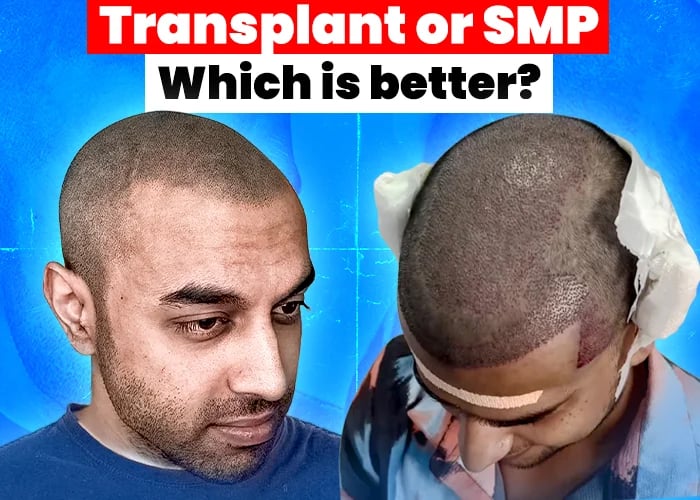Free Consultation, Call Now 416-902-2126
Scalp Micropigmentation vs. Hair Transplant: Making the Right Choice for You
Choosing between scalp micropigmentation (SMP) and a hair transplant can be challenging, as both offer solutions for hair loss but work in different ways. This blog compares the two procedures, covering factors like cost, recovery time, results, and maintenance. Learn the pros and cons of each treatment and discover which option best suits your hair restoration goals. If you're considering SMP, AtruBarber in Oshawa provides expert consultations to help you make an informed decision for natural-looking results.
2/22/20255 min read


Understanding Scalp Micropigmentation (SMP)
Scalp micropigmentation (SMP) is an innovative cosmetic procedure designed to replicate the appearance of natural hair follicles on the scalp. Essentially, it involves the use of specialized tattoo machines that apply pigment to the epidermis in a manner that mimics the look of closely shaved hair. This technique offers an effective solution for various types of hair loss, including thinning hair, receding hairlines, and complete baldness.
The SMP procedure typically involves multiple sessions, during which trained professionals skillfully deposit small dots of pigment into the scalp. The technology used in SMP combines precision with artistry to create a realistic look, effectively restoring the illusion of density in thinning areas. This is especially beneficial for individuals seeking a non-surgical option to address their hair loss concerns.
One of the significant advantages of scalp micropigmentation is its immediate results. After just a few sessions, clients can achieve the desired aesthetic effect without undergoing invasive surgical methods. Additionally, SMP requires minimal downtime, allowing individuals to resume their normal activities shortly after treatment. The results of this procedure are also long-lasting, with many clients enjoying their new look for several years before requiring touch-ups.
However, it is essential to consider potential disadvantages and side effects. While the risks involved are relatively low compared to surgical options, some individuals may experience mild irritation or allergic reactions to the pigment. Moreover, it's crucial to choose a qualified practitioner to ensure optimal results and minimize complications. Aftercare commitment is another consideration, as clients may need to follow specific guidelines to maintain their SMP results and protect their scalp from sun exposure.
In summary, understanding the fundamentals of scalp micropigmentation is vital for anyone contemplating this procedure as a viable solution for hair loss. By weighing the benefits and potential drawbacks, individuals can make informed decisions regarding their hair restoration options.
Exploring Hair Transplant Options
Hair transplant procedures are increasingly sought after as effective solutions to hair loss. Among the most well-known methods are Follicular Unit Extraction (FUE) and Follicular Unit Transplantation (FUT). Understanding these techniques can assist individuals in making informed decisions about which options best suit their needs.
FUE involves the extraction of individual hair follicles from a donor area, typically the back of the scalp, which are then transplanted to the balding or thinning areas. This technique is less invasive than traditional methods and usually results in minimal scarring. Patients can generally expect the procedure to last several hours, depending on the extent of the area being treated. Recovery from FUE is relatively quick, with most patients resuming normal activities within a few days. The final results typically become apparent after several months as the transplanted hair grows.
On the other hand, FUT, often referred to as the strip method, entails removing a strip of skin containing hair follicles from the donor site. The follicles are then dissected and transplanted as grafts. This technique can sometimes yield a larger number of grafts in a single session, making it suitable for those requiring extensive coverage. However, the recovery period may take longer due to the need for stitches, and there can be more noticeable scarring compared to FUE.
Cost is an essential factor in choosing hair transplant surgery, as it can vary significantly based on the method used, the clinic, and the geographical location. Additionally, eligibility for procedures can depend on the degree of hair loss, donor hair availability, and overall health. Maintenance thereafter generally involves following a specific hair care routine and possibly taking medications to promote continued growth.
Understanding these differing methods, recovery timelines, costs, and maintenance needs can greatly inform individuals as they consider their options in the realm of hair restoration.
Comparative Analysis: SMP vs. Hair Transplant
When considering hair restoration options, scalp micropigmentation (SMP) and hair transplants are two popular choices each with its unique benefits and limitations. An effective comparison requires an examination of several critical factors including effectiveness, cost, pain level, recovery time, and permanency.
In terms of effectiveness, scalp micropigmentation provides an immediate visual impact, creating the appearance of fuller, thicker hair through the application of pigment on the scalp. In contrast, hair transplants involve relocating hair follicles from one part of the body to another, which can yield more natural results over time but may take several months to fully see results. Effectiveness, therefore, can vary significantly between the two methods based on individual circumstances.
Cost is another important aspect to consider. SMP generally has a lower upfront cost than hair transplants, making it an attractive option for those on a budget. Hair transplants, while typically more expensive, may offer a more permanent solution, as the transplanted follicles can grow hair naturally for years, whereas SMP requires touch-ups to maintain its appearance.
Regarding pain levels, SMP is considered less invasive, usually resulting in minor discomfort during the session, while hair transplants can involve more significant pain due to surgical procedures. Recovery time is markedly different as well; SMP allows individuals to return to their daily routines almost immediately, whereas hair transplants may necessitate a longer recovery period with restrictions on physical activity.
In terms of permanency, hair transplants are generally viewed as a longer-lasting solution, as the transplanted hair grows much like natural hair. However, SMP can create a lasting aesthetic impression, but periodic maintenance is essential to keep the pigment looking fresh.
Satisfaction rates also vary; many individuals report high satisfaction with both procedures, but the level of contentment often depends on the individual's expectations and personal preferences. Ultimately, evaluating the pros and cons of each treatment can guide individuals in making an informed choice that aligns with their hair restoration goals and lifestyle requirements.
Making the Decision: Factors to Consider
When contemplating hair restoration options, it is essential to weigh several factors that will influence the decision between scalp micropigmentation (SMP) and hair transplant surgery. One of the foremost considerations is the individual’s budget. Hair transplants can pose a significant financial investment depending on the extent of the procedure, while SMP tends to be more cost-effective. Understanding your financial capacity and determining which option aligns with your monetary constraints is crucial.
The degree of hair loss is another critical factor in this decision-making process. Individuals exhibiting early-stage hair thinning may find SMP an ideal solution to conceal hair loss, whereas those with moderate to severe baldness may benefit more from a hair transplant, which offers the potential for a fuller hairline. Assessing the severity of your hair loss can guide you to the option that best addresses your situation.
Lifestyle considerations are also vital. For example, a busy schedule may make the extended recovery time associated with hair transplant surgery less appealing, as opposed to the non-invasive nature of SMP that allows for quicker results and minimal downtime. Understanding how each procedure aligns with your daily routine can aid in your decision. Additionally, you should reflect on your individual goals regarding appearance. If the goal is a natural shadow of hair that enhances overall aesthetics, SMP may be favorable. Conversely, those seeking to restore actual hair may lean toward hair transplant surgery.
Finally, consulting with professionals specializing in these methods is highly recommended. They can provide personalized insights tailored to your unique circumstances. They will assist in clarifying the potential impacts on your overall well-being and help you make an informed decision that resonates with your personal hair restoration journey.
